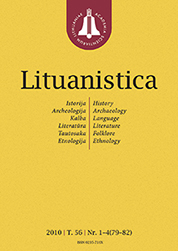LituanisticaWHAT?
 ISSN 0235-716X |
2006 m. Nr. 4 Dvasingumo ir etniškumo atspindžiai šv. Kazimierui skirtuose apeiginiuose papročiuose Lietuvoje
The Liturgy of the Catholic Church consists of the Holy Mass and additional devotional practices, or folk devotions, performed outside the Mass in the local language. These devotional practices or folk rituals are used by the local people. Nowadays we can find these practices in the Church calendar, among the prayers, hymns and songs of national feasts, memorable days or additional devotions (Hours of Our Lady, the Rosary of Our Lady and of Jesus’ Name, performed orally or by singing, Samogitian Calvaries, Stations of the Cross, Lamentations on the Passions of Christ and Mourning Psalms in commemoration of the dead. Among them, there are feasts of different Lithuanian saints and the blessed. A saint or a blessed one is a person because of his or her special characteristics treated as a very religious personality. In the course of centuries, Lithuania had a lot of prominent people, wise rulers, brave men or sages. But it never had or has many saints, at least those publicly proclaimed as such. There are only two officially recognized as blessed persons – the archbishop Jurgis (George) Matulaitis and Mykolas (Michael) Giedraitis. There is a woman – Barbora Žagarietė – with a fame of sanctity among the local people, who worshiped her as a saint for some centuries, creating different forms of rituals and devotions, but still she is not an official saint. The only declared saint in Lithuania is St. Casimir, in different ethnic regions honoured by different devotions. There are quite a lot scientific materials about the cult of St. Casimir either in Lithuania or all over the world, but very little is said about the folk devotions and rituals concerning St. Casimir, except the author’s material presented in the textbook “Catholic Folk Devotional Practices in Lithuania” (2004) and materials of summer expeditions of 1995–2000. So the aim of the current research was to reveal the peculiarities of St. Casimir’s cult, its spirituality and ethnicity in different parts of Lithuania with its local devotions. There are two tasks to solve in order to reach this aim: firstly, to find out ritual devotions of this cult among local people; secondly, to describe the origin and peculiarities of this phenomenon. The hypothesis of the research was that the rituals of folk devotional practices in St. Casimir’s cult and its spirituality and ethnocity are different among the different ethnographic regions of Lithuania. In order to elucidate this idea, archival sources of summer expeditions were used, both personal and of the Institute of St. Anthony Religious Studies at the Catholic Faculty of Vytautas Magnus University. The results of the study allowed the following conclusions: • the cult of St. Casimir in Lithuania is of local origin, i. e it is best known only in the regions close to Poland (Highlands and Suvalkija); • St. Casimir’s folk devotional practices consist of ten rituals; • from these ten rituals, four are of local origin, four come from Poland, and two follow from the teaching of the Church or examples from St. Casimir’s life; • Highlands are richest in ethnographic features (four are in the Vilnius archdiocese and
one in the Kaunas archdiocese). Suvalkija (Vilkaviškis diocese) and Samogitia (Telšiai diocese) each have two ritual customs. All the ethnographic regions have a unifying custom which is singing of hymns; • the cult of St. Casimir is a symbol of Polish and Lithuanian spirituality, their fight for religious freedom, against paganism, Protestantism, Islam and Orthodoxy and their remembrance. • local ritual customs: women with their hair and faces hidden under kerchiefs or going on bare feet (the symbol of woman’s chastity), and the cloth from St. Casimir’s relics, keeping pieces from it as a sign of Catholic women’s respect and adoration of St. Casimir. The conclusions motivate the thesis of the research that the folk devotional practices of St. Casimir with their spiritual and ethnic aspects are different in different ethnographic regions of Lithuania. |
Numeriai:
2011 - T.57 Nr.1, Nr.2, Nr.3, Nr.4 2010 - T.56 Nr.1-4 2009 - T.55 Nr.1-2, Nr.3-4 2008 - T.54 Nr.1, Nr.2, Nr.3, Nr.4 2007 - T.53 Nr.1, Nr.2, Nr.3, Nr.4 2006 Nr.1, Nr.2, Nr.3, Nr.4 2005 Nr.1, Nr.2, Nr.3, Nr.4 2004 Nr.1, Nr.2, Nr.3, Nr.4 2003 Nr.1, Nr.2, Nr.3, Nr.4 2002 Nr.1, Nr.2, Nr.3, Nr.4 2001 Nr.1, Nr.2, Nr.3, Nr.4 |